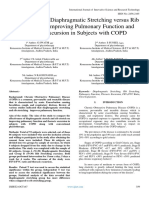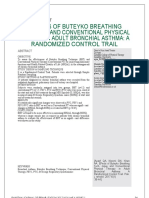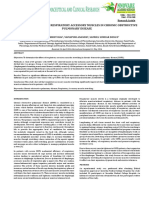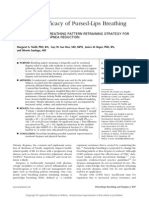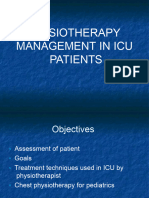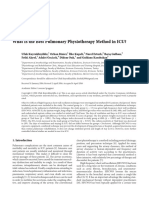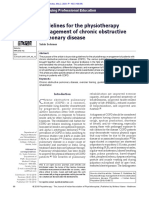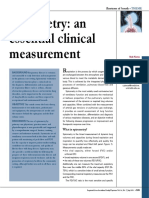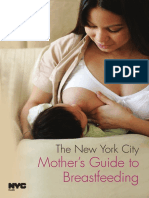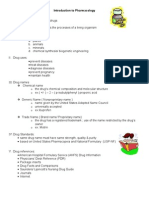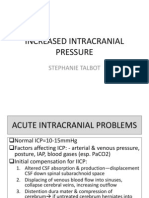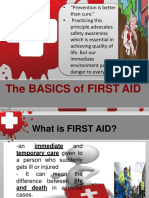Professional Documents
Culture Documents
Bhramari Pranayama and Thoracic Mobility Exercises For Moderate Chronic Obstructive Pulmonary Disease (COPD) : A Case Study
Bhramari Pranayama and Thoracic Mobility Exercises For Moderate Chronic Obstructive Pulmonary Disease (COPD) : A Case Study
Original Title
Copyright
Available Formats
Share this document
Did you find this document useful?
Is this content inappropriate?
Report this DocumentCopyright:
Available Formats
Bhramari Pranayama and Thoracic Mobility Exercises For Moderate Chronic Obstructive Pulmonary Disease (COPD) : A Case Study
Bhramari Pranayama and Thoracic Mobility Exercises For Moderate Chronic Obstructive Pulmonary Disease (COPD) : A Case Study
Copyright:
Available Formats
Volume 9, Issue 4, April – 2024 International Journal of Innovative Science and Research Technology
ISSN No:-2456-2165 https://doi.org/10.38124/ijisrt/IJISRT24APR1104
Bhramari Pranayama and Thoracic Mobility
Exercises for Moderate Chronic Obstructive
Pulmonary Disease (COPD): A Case Study
N Mageswaran1 Supritha Rao2
Principal BPT Intern, KVG Institute of Physiotherapy,
Aditya College of Physiotherapy, Sullia, Dakshina Kannada, India
Bangalore, India
Syamala Maheshwari3
Lecturer
Aditya College of Physiotherapy,
Bangalore, India
Abstract:- Chronic obstructive pulmonary disease approximately 41.9 deaths per 100000 individuals (5.7% of
(COPD) is a global health issue and a significant cause of total all-cause deaths). [3]
morbidity, disability, and mortality due to persistent
respiratory symptoms and airflow limitations. COPD is The risk factors for COPD are tobacco smoking,
diagnosed through pulmonary function testing, occupational exposures, air pollution, genetic factors, age,
particularly spirometry, which measures the post gender, lung growth and development, low socio-economic
bronchodilator FEV1/FVC ratio. The purpose of this status, respiratory infections, asthma and airway hyper-
study was to determine the effectiveness of Bhramari reactivity. The symptoms are dyspnea, chronic cough,
pranayama combined with thoracic mobility exercises on sputum production, wheezing, chest tightness, fatigue,
increasing exercise/activity tolerance in patient with weight loss, pedal edema (due to cor pulmonale), depression
moderate COPD. This case study is about a 60-year-old and anxiety. [4]
male with COPD who presented with breathlessness,
cough, and mMRC grade 2 dyspnoea. His FEV1 was COPD is typically identified based on symptoms and
58%, FVC was 75%, and FEV1/FVC (post associated risk factors. Pulmonary Function Testing (PFT) is
bronchodilator) was 63%. The patient was given utilized to diagnose, stage, and monitor the condition. This
Bhramari pranayama and thoracic mobility exercise for includes spirometry, laboratory testing, 6-minute walk tests,
a period of 4 days. After 4 days, there was improvement imaging of the lungs through radiography, oxygenation tests
in dyspnoea severity, exercise capacity, thoracic such as pulse oximetry or arterial blood gas analysis.
expansion, FEV1, FVC, FEV1/FVC, and CAT Diagnosing COPD is specifically done through spirometry,
questionnaire score. Hence, we concluded that Bhramari where the post bronchodilator FEV1/FVC must be less than
Pranayama and thoracic mobility exercises are effective 0.7 for the diagnosis to be established. [5]
in increasing exercise/activity tolerance in patient with
moderate COPD. Pranayama is generally a technique of prolongation
and control of breath. Prana means 'vital energy' or 'life
Keywords:- Bhramari Pranayama, Thoracic Mobility force’ and Ayama means 'extension' or 'expansion' in
Exercises, COPD, Case Study. Sanskrit. Bhramari is a type of pranayama. It is simple and
can be practiced by everyone irrespective of their age or
I. INTRODUCTION gender. To practice Bhramari pranayama, the practitioner
should sit in a comfortable pose and take slow, deep breaths
Davidson’s principles and practices of medicine through the nostrils. Upon exhaling, they must produce a
defines Chronic Obstructive Pulmonary Disease (COPD) as humming sound similar to that of a bumble bee with the lips
a preventable and treatable disease characterized by closed and ears blocked by fingers. [6]
persistent respiratory symptoms and airflow limitation that
is due to airway and/or alveolar abnormalities, usually Patients with COPD frequently experience dyspnea
caused by significant exposure to noxious particles or during normal daily activities when they use their upper
gases.[1] COPD is one of the important causes of morbidity, extremities. Furthermore, since the muscles responsible for
disability and mortality around the globe with a high arm movements and trunk stabilization are connected to the
prevalence (approximately 10%) in the population aged rib cage, this increases chest wall resistance, thereby
between 30-79 years. [2] The 2017 Global Burden of Disease limiting one's ability to increase tidal volume during arm
(GBD) study estimates that the global mortality of COPD is activities. Thoracic mobility exercises including active upper
IJISRT24APR1104 www.ijisrt.com 1248
Volume 9, Issue 4, April – 2024 International Journal of Innovative Science and Research Technology
ISSN No:-2456-2165 https://doi.org/10.38124/ijisrt/IJISRT24APR1104
limb exercises are effective in reducing dyspnea and Palpation
improving lung function, functional capacities and quality of
life in patients with COPD.[7,8] All findings from inspection were confirmed.
Trachea- Centrally placed.
II. CASE DESCRIPTION Movements of chest- Reduced bilaterally.
Tactile fremitus- Normal and equivocal.
A. Subjective assessment Thoracic expansion measurement difference during
inspiration and expiration-
Chief Complaints-
A 60- year old male with the history of COPD Axillary level- 1.5cm
presented with the complaints of breathlessness, cough with Nipple level-1cm
difficulty in expelling the phlegm and easy fatigability. Xiphoid level-1cm
History of Present Illness – Auscultation
Patient was said to be apparently normal 4 years ago,
then he developed dyspnoea, which was insidious in onset, Breath sounds- Decreased intensity of breath sounds.
gradually progressive in nature, initially of Grade 1 Vocal fremitus -Normal and equivocal
Modified Medical Research Council (mMRC) progressed to
Grade 2 mMRC in past 2 years. Dyspnoea aggravates on C. Investigations
walking, stair climbing and going slight uphill, relieves on
taking medications, no seasonal variations and no diurnal Chest X-ray –
changes. The patient had COPD Assessment Test(CAT)
score of 25. Patient had cough since 4 years which was Lung hyper inflation
insidious in onset, gradually progressive in nature and Flattened hemi-diaphragms
associated with expectorations (scanty, whitish and mucoid
consistency). Patient had easy fatigability which was PFT(Spirometry)-
insidious in onset, gradually progressive, aggravates during
exacerbation and relieves by taking rest. The patient was FEV1- 58%
thus admitted to the KVG Medical College and Hospital's FVC- 75%
inpatient unit of the respiratory medicine and was referred FEV1/FVC (post bronchodilator)- 63%
for physiotherapy.
III. INTERVENTION
B. Objective Assessment
The patient undertook a course of physiotherapy
Physical Examination
treatment consisting of Bhramari pranayama and thoracic
mobility exercises for a period of 4 days.
Initial Physical Exam-
Temperature 97.5°F, heart rate 80bpm, SpO2 98% on Bhramari Pranayama
room air, respiratory rate 21 breaths/min, BP 130/80mmHg,
height 169cm, weight 60kg, BMI 21kg/m2.Patient was Frequency- 3 times/day
pallor. No icterus, cyanosis, clubbing, lymphadenopathy or
Time-15 minutes
edema.
Type- Breathing exercise
Constitutional-
Thoracic Mobility Exercises
Moderately built, well nourished, conscious, co-
operative, well oriented to time, place and person.
Frequency-3 times/day
Systemic Examination Intensity- According to patient’s tolerance level
Time-15 minutes
CVS- S1 and S2 heard, no murmur. Type-Range of motion exercise
CNS- No focal neurological deficit. Along with physiotherapy, the patient also received
bronchodilators and mucolytics.
Respiratory System-
Inspection
Shape of chest – Barrel
Trachea- Appears to be placed centrally
Movements of chest- Reduced bilaterally
Accessory muscle usage- Not seen
IJISRT24APR1104 www.ijisrt.com 1249
Volume 9, Issue 4, April – 2024 International Journal of Innovative Science and Research Technology
ISSN No:-2456-2165 https://doi.org/10.38124/ijisrt/IJISRT24APR1104
Fig 1 Patient Performing Bhramari Pranayama Fig 2 Patient Performing Thoracic Mobility Exercise
IV. RESULTS
Table 1 Results
Outcome measures Values
Pre treatment Post treatment
mMRC Grade 2 Grade 1
CAT questionnaire 25 11
6 minute walk distance( The predicted value was from 411m to 563.5m for the patient) 405m 420m
PFT(spirometry)
FEV1 58% 64%
FVC 75% 79%
FEV1/FVC 63% 75%
Thoracic expansion measurement difference
Axillary level 1.5cm 1.8cm
Nipple level 1cm 1.4cm
Xiphoid level 1cm 1.6cm
V. DISCUSSION the effect of Yoga breathing (Pranayama) on exercise
tolerance in patients with COPD. They concluded that
This study aimed to determine the effectiveness of pranayama was associated with improved exercise tolerance
Bhramari pranayama combined and thoracic mobility in patients with COPD and may have significant clinical
exercises on increasing exercise/activity tolerance in patient benefits for symptomatic patients with COPD. [13]
with moderate COPD. A significant reduction was observed
in dyspnoea after the treatment in the patient. The exercise The muscles of the upper ribcage and shoulder girdle,
tolerance improved on the other side. which are responsible for respiratory and postural functions,
have thoracic and extra thoracic attachment points. Any
During the pranayama, the lung inflates to the exercise that affects shoulder or trunk will mobilize the
maximum, stimulating pulmonary stretch receptors. The chest. [14] Upper extremity muscular training enhances the
stretch receptors reduce the tracheobronchial smooth muscle strength of the inspiratory muscles and improves ADL
tone, resulting in decreased airway resistance and improved performance in patients with COPD. It also decreases
pulmonary function. [9] A study done by Jaysheela H states fatigue and dyspnea perception during ADL. [15,16] The
that Bhramari pranayama is effective in minimizing thoracic mobility exercises address both the structural and
dyspnoea in COPD patients and improving their pulmonary functional aspects of respiratory health, promoting optimal
functions. [10] The controlled breath and vibrational hum lung mechanics, enhancing endurance, and improving
contribute to strengthening of respiratory muscles. The overall quality of life for individuals navigating the
resonance created during humming sound stimulates the complexities of COPD.
vagus nerve, which raises vagal tone and activates the
parasympathetic nervous system. Thus, promoting relaxation This study has limitations, the subject received
and influencing respiratory regulation. [11,12] Kaminsky DA bronchodilators and mucolytics. This might also have had an
et al. (2017) at Vermont and Texas, USA, conducted a impact on dilating the bronco tubes, loosening the secretions
randomized double-blind, controlled pilot trial to find out and expelling the phlegm. The study was conducted only for
IJISRT24APR1104 www.ijisrt.com 1250
Volume 9, Issue 4, April – 2024 International Journal of Innovative Science and Research Technology
ISSN No:-2456-2165 https://doi.org/10.38124/ijisrt/IJISRT24APR1104
4 days and the long term effects were not analyzed. So, [4]. GOLD. Global initiative for chronic obstructive lung
further study with large population size is recommended to disease global strategy for the diagnosis,
evaluate the effectiveness of Bhramari Pranayama combined management, and prevention of chronic obstructive
and thoracic mobility exercises on increasing pulmonary disease 2023 report[Internet].2023.
exercise/activity tolerance in patient with moderate COPD. Available from: https://goldcopd.org .
[5]. Agarwal AK, Raja A, Brown BD. Chronic
VI. CONCLUSION obstructive pulmonary disease. National Centre for
Biotechnology Information [Internet].Florida:
The present study demonstrated that Bhramari StatPearls Publishing;2022. Available from:
pranayama has positive impact on dyspnoea and loosening https://pubmed.ncbi.nlm.nih.gov/32644707/ .
secretions. The thoracic mobility exercises help in [6]. Saraswati S.S. Asana Pranayama Mudra Bandha
maintaining the range of motion on upper limb and [Internet]. Bihar, India: Yoga Publications Trust;
strengthen the respiratory muscles. When Bhramari 2009. Available from: https://thelonerider.com/
pranayama is combined with thoracic mobility exercises, it pdf/asana_pranayama_mudra_bandha.pdf .
can improve the exercise/activity tolerance of the patient. [7]. Tarigan AP, Ananda FR, Pandia P, Sinaga BY,
Hence, improving the quality of life. Maryaningsih M, Anggriani A. The impact of upper
limb training with breathing maneuver in lung
Patient Informed Consent: function, functional capacity, dyspnea scale, and
A written consent was obtained from the patient. quality of life in patient with stable chronic
obstructive of lung disease. Open Access Maced J
Funding: Med Sci [Internet]. 2019;7(4):p567–572. Available
No external funding received. from: http://dx.doi.org/10.3889/oamjms.2019.113
doi:10.3889/oamjms.2019.113.
Conflicts of Interest: [8]. Mulay SU, Devi TP, Jagtap VK. Effectiveness of
There is no conflict of interest concerned with this shoulder and thoracic mobility exercises on chest
study. expansion and dyspnoea in moderate chronic
obstructive pulmonary disease patients. Int J
ACKNOWLEDGEMENT Physiother Res [Internet]. 2017;5(2):p1960–1965.
Available from: https://www.ijmhr.org/IntJPhysiother
We extend our sincere gratitude to Dr. Dinesh P V Res/IJPR.2017.115 doi: 10.16965/ijpr.2017.115.
(department of community medicine) and Dr. Prithiraj Ballal [9]. Raju Nr N, Deepika S, Pratibha K, Tr KP, Navoday
(department of pulmonary medicine) of KVG Medical NR, Scholar RPG. Effects of pranayama on
College and Hospital, for their valuable suggestions and respiratory system [Internet]. Ujconline.net. Available
guidance. from: http://ujconline.net/wp-content/uploads/2013/
09/16-UJAHM-15222-Rv.pdf.
REFERENCES [10]. Jayasheela H. Effect of Bhramari pranayama on
dyspnoea among patients with chronic obstructive
[1]. Reid PT, Innes JA. Respiratory medicine. In: Ralston pulmonary disease. Indian Journal of Public Health
S H, Penman I D, Strachan M W J, Hobson R P Research & Development[Internet],2021;12(2):p
(Eds). Davidson’s principles and practices of 147–152. Available from:
medicine. 24th ed. London: Elsevier;2022. p479-556. https://medicopublication.com/index.php/ijphrd/articl
[2]. Adeloye D, Song P, Zhu Y, Campbell H, Rudan I; e/view/14108 doi; 10.37506/ijphrd.v12i2.14108
NIHR RESPIRE Global Respiratory Health Unit. [11]. Trivedi G, Sharma K, Saboo B, Kathirvel S, Konat
Global, regional, and national prevalence of, and risk A, Zapadia V, et al. Humming (simple bhramari
factors for, chronic obstructive pulmonary disease pranayama) as a stress buster: A Holter-based study
(COPD) in 2019: a systematic review and modelling to analyze heart rate variability (HRV) parameters
analysis. Lancet Respir Med[Internet]. 2022;10(5): during bhramari, physical activity, emotional stress,
p447-458.Available from: and sleep. Cureus [Internet]. 2023; Available from:
https://www.thelancet.com/journals/lanres/article/PII http://dx.doi.org/10.7759/cureus.37527
S2213-2600(21)00511-7/fulltext doi: 10.1016/ [12]. Kuppusamy M. Immediate effects of bhramari
S2213-2600(21)00511-7. pranayama on resting cardiovascular parameters in
[3]. Soriano JB, Kendrick PJ, Paulson KR, Gupta V, healthy adolescents. J Clin Diagn Res [Internet].
Abrams EM, Adedoyin RA, et al; GBD Chronic 2016; Available from: http://dx.doi.org/10.7860/
Respiratory Disease Collaborators. Prevalence and jcdr/2016/19202.7894
attributable health burden of chronic respiratory [13]. Kaminsky DA, Guntupalli KK, Lippmann J, Burns
diseases, 1990–2017: a systematic analysis for the SM, Brock MA, Skelly J, et al. Effect of yoga
global burden of disease study 2017. Lancet Respir breathing (pranayama) on exercise tolerance in
Med[Internet]. 2020;8(6):p585–596. Available from: patients with chronic obstructive pulmonary disease:
https://www.thelancet.com/journals/lanres/article/PII A randomized, controlled trial. J Altern Complement
S2213-2600(20)30105-3/fulltext doi: 10.1016/ Med [Internet]. 2017;23(9):p696–704. Available
S2213-2600(20)30105-3. from: http://dx.doi.org/10.1089/acm.2017.0102.
IJISRT24APR1104 www.ijisrt.com 1251
Volume 9, Issue 4, April – 2024 International Journal of Innovative Science and Research Technology
ISSN No:-2456-2165 https://doi.org/10.38124/ijisrt/IJISRT24APR1104
[14]. Watchie J. Cardiovascular and pulmonary physical
therapy: A clinical manual. 2nd ed. St. Louis:
Saunders; 2009.p319-322.
[15]. Hulya Arikan, Ebru Calik-Kutukcu, Naciye Vardar-
Yagli, Melda Saglam, Cigdem Oksuz, Deniz Inal-
Ince, et al. Effect of upper extremity training on
respiratory muscle strength, activities of daily living
and fatigue perception in patients with chronic
obstructive pulmonary disease. Eur Respir J
[Internet]. 2014;44(Suppl 58):P1290. Available from:
http://erj.ersjournals.com/content/44/Suppl_58/P1290
.abstract.
[16]. Permatasari Tarigan A, Rizki Ananda F. Exercise
Training and Pulmonary Rehabilitation in COPD
[Internet]. Chronic Obstructive Pulmonary Disease -
A Current Conspectus. IntechOpen; 2021. Available
from:http://dx.doi.org/10.5772/intechopen.97704.
IJISRT24APR1104 www.ijisrt.com 1252
You might also like
- Chronic Kidney Disease Case PresDocument32 pagesChronic Kidney Disease Case Presnnaesor_1091No ratings yet
- Effectiveness of Diaphragmatic Stretching Versus Rib Stretching On Improving Pulmonary Function and Thoracic Excursion in Subjects With COPDDocument9 pagesEffectiveness of Diaphragmatic Stretching Versus Rib Stretching On Improving Pulmonary Function and Thoracic Excursion in Subjects With COPDInternational Journal of Innovative Science and Research TechnologyNo ratings yet
- Autogenic 1 PDFDocument5 pagesAutogenic 1 PDFpermanaNo ratings yet
- Copd 10 1703Document7 pagesCopd 10 1703brikitabelaNo ratings yet
- Copd 10 1703Document7 pagesCopd 10 1703Maria Camila SanabriaNo ratings yet
- Efficacy of Retraining Diaphragm by Proprioceptive Neuromuscular Facilitation Versus Diaphragmatic Breathing Exercises in Reducing Dyspnoea in The Copd PatientsDocument4 pagesEfficacy of Retraining Diaphragm by Proprioceptive Neuromuscular Facilitation Versus Diaphragmatic Breathing Exercises in Reducing Dyspnoea in The Copd PatientsInternational Journal of Innovative Science and Research TechnologyNo ratings yet
- A Study of Efficiency of Breathing Exercises To Improve Pulmonary FX in SCi PtsDocument6 pagesA Study of Efficiency of Breathing Exercises To Improve Pulmonary FX in SCi PtsMarion AtienzaNo ratings yet
- IPG CF - Blue Booklet - 7th Edition 2019Document74 pagesIPG CF - Blue Booklet - 7th Edition 2019bogdan almajanNo ratings yet
- Effects of Buteyko Breathing Technique and Conventional Physical Therapy in Adult Bronchial Asthma: A Randomized Control TrailDocument3 pagesEffects of Buteyko Breathing Technique and Conventional Physical Therapy in Adult Bronchial Asthma: A Randomized Control TrailMuhammad YozaNo ratings yet
- Amira Permatasari Tarigan, Fannie Rizki Ananda, Pandiaman Pandia, Bintang YM Sinaga, Maryaningsih Maryaningsih, Anggriani AnggrianiDocument6 pagesAmira Permatasari Tarigan, Fannie Rizki Ananda, Pandiaman Pandia, Bintang YM Sinaga, Maryaningsih Maryaningsih, Anggriani AnggrianiDurratun NusrahNo ratings yet
- Airway Clearance DysfunctionDocument27 pagesAirway Clearance Dysfunctionane2saNo ratings yet
- KEY TO CardioDocument7 pagesKEY TO CardiomohtishimNo ratings yet
- Ejercicio DiafragmaticoDocument3 pagesEjercicio DiafragmaticoN onlyNo ratings yet
- Chest Physiotherapy or Techniques in Cardio Pulmonary Physiotherapy A Running CommentaryDocument5 pagesChest Physiotherapy or Techniques in Cardio Pulmonary Physiotherapy A Running CommentaryGopi KrishnanNo ratings yet
- Copd Lesson PlanDocument14 pagesCopd Lesson PlanAmrita pathakNo ratings yet
- Effectiveness of Chest Physical Therapy in Improving Quality of Life and Reducing Patient Hospital Stay in Chronic Obstructive Pulmonary DiseaseDocument5 pagesEffectiveness of Chest Physical Therapy in Improving Quality of Life and Reducing Patient Hospital Stay in Chronic Obstructive Pulmonary DiseaseAn O NimNo ratings yet
- Research Proposal: MPT (Cardio Respiratory Disorders)Document14 pagesResearch Proposal: MPT (Cardio Respiratory Disorders)permanaNo ratings yet
- Emphysema Case Study AnalysisDocument10 pagesEmphysema Case Study AnalysisEfren VisteNo ratings yet
- Neuromuscular Paper-Sierra MooreDocument7 pagesNeuromuscular Paper-Sierra Mooreapi-364421826No ratings yet
- BronchiectasisDocument7 pagesBronchiectasisNelson LoboNo ratings yet
- 1 s2.0 S1836955315001009 MainDocument8 pages1 s2.0 S1836955315001009 Maindchttk6htvNo ratings yet
- Breathing StretchesDocument4 pagesBreathing StretchesBrandon SwinfordNo ratings yet
- Combined Pulmonary Fibrosis and Emphysema: Effect of Pulmonary Rehabilitation in Comparison With Chronic Obstructive Pulmonary DiseaseDocument10 pagesCombined Pulmonary Fibrosis and Emphysema: Effect of Pulmonary Rehabilitation in Comparison With Chronic Obstructive Pulmonary DiseasePrasasti 19No ratings yet
- Effect of Treadmill Walking Training With Deep Breathing Exercises On Pulmonary Functions in PatieDocument5 pagesEffect of Treadmill Walking Training With Deep Breathing Exercises On Pulmonary Functions in PatieMuhajir AjiNo ratings yet
- Comparison of Effectiveness of Diaphragmatic Breathing and Pursedlip Expiration Exercises in Improving The Forced Expiratory Flow Rate and Chest Expansion in Patients With Bronchial AsthmaDocument5 pagesComparison of Effectiveness of Diaphragmatic Breathing and Pursedlip Expiration Exercises in Improving The Forced Expiratory Flow Rate and Chest Expansion in Patients With Bronchial AsthmaInternational Journal of PhysiotherapyNo ratings yet
- Key Points: Breathe - December 2017 - Volume 13 - No 4Document12 pagesKey Points: Breathe - December 2017 - Volume 13 - No 4thania devianithaNo ratings yet
- Nair 2019Document8 pagesNair 2019Anonymous VjiuWvATgNo ratings yet
- Conventional Chest Physical Therapy For Obstructive Lung DiseaseDocument12 pagesConventional Chest Physical Therapy For Obstructive Lung DiseaseJulieta EvangelistaNo ratings yet
- Hakala2000 PDFDocument7 pagesHakala2000 PDFVanshika GuptaNo ratings yet
- Physiotherapy Management in Icu Patients: Dr.S.Ramachandran MPTDocument37 pagesPhysiotherapy Management in Icu Patients: Dr.S.Ramachandran MPTvaishnaviNo ratings yet
- Efficacy of Pursed-Lips Breathing: A Breathing Pattern Retraining Strategy For Dyspnea ReductionDocument8 pagesEfficacy of Pursed-Lips Breathing: A Breathing Pattern Retraining Strategy For Dyspnea ReductionGaoudam NatarajanNo ratings yet
- Pjms 32 1152Document6 pagesPjms 32 1152api-459288956No ratings yet
- Copd CaseDocument36 pagesCopd Casejho_No ratings yet
- Guidelines For The Physiotherapy Management of Chronic Obstructive Pulmonary DiseaseDocument7 pagesGuidelines For The Physiotherapy Management of Chronic Obstructive Pulmonary DiseaseAyu AryaDewi PasyaViraNo ratings yet
- School of Nursing and Allied Medical Sciences: Holy Angel UniversityDocument19 pagesSchool of Nursing and Allied Medical Sciences: Holy Angel UniversityMonica BorjaNo ratings yet
- PT in ICUDocument38 pagesPT in ICUArun KumarNo ratings yet
- Remote Exercise Testing For Respiratory Disease During Covid 19Document18 pagesRemote Exercise Testing For Respiratory Disease During Covid 19Chelsea Shannen Marie CarreonNo ratings yet
- Teknik Acbt Untuk Kasus BronkhiektasisDocument9 pagesTeknik Acbt Untuk Kasus Bronkhiektasisfister19 rifaudinNo ratings yet
- Clinical Study: What Is The Best Pulmonary Physiotherapy Method in ICU?Document5 pagesClinical Study: What Is The Best Pulmonary Physiotherapy Method in ICU?Sofranita Ladyas PutriNo ratings yet
- Maintenance of Inspiratory Muscle Training in COPD Patients: One Year Follow-UpDocument5 pagesMaintenance of Inspiratory Muscle Training in COPD Patients: One Year Follow-UpGaoudam NatarajanNo ratings yet
- Enhancing Pulmonary Function and Arterial Blood GaDocument12 pagesEnhancing Pulmonary Function and Arterial Blood Gaاحمد العايديNo ratings yet
- Fisioterapi Ppok EngDocument7 pagesFisioterapi Ppok EngEi lessonNo ratings yet
- Breathing Re-Education and Phenotypes of Sleep Apnea - A ReviewDocument21 pagesBreathing Re-Education and Phenotypes of Sleep Apnea - A ReviewKarol SilveiraNo ratings yet
- Pulmonary Function TestDocument19 pagesPulmonary Function TestAshenafi BerhanuNo ratings yet
- Series 'Chest Physical Examination' Edited by J.C. Yernault: B. Maitre, T. Similowski, J-P. DerenneDocument10 pagesSeries 'Chest Physical Examination' Edited by J.C. Yernault: B. Maitre, T. Similowski, J-P. DerenneIhms DelhiNo ratings yet
- COPDDocument47 pagesCOPDMegha VadanereNo ratings yet
- Spirometry: An Essential Clinical MeasurementDocument5 pagesSpirometry: An Essential Clinical MeasurementMarc AbellaNo ratings yet
- Airway Management For Nurses PDFDocument6 pagesAirway Management For Nurses PDFarizza ramosNo ratings yet
- Pulmonary RehabilitationDocument31 pagesPulmonary RehabilitationahmedNo ratings yet
- Medi 99 E23646Document8 pagesMedi 99 E23646panumatkhamphiranonNo ratings yet
- Safavi 2020Document8 pagesSafavi 2020АлинаNo ratings yet
- Gold Guideline PresentationDocument50 pagesGold Guideline PresentationDiptta BhattacharjeeNo ratings yet
- Arm and Foot BathDocument10 pagesArm and Foot BathDr Siddharth SP YadavNo ratings yet
- Breathing Exercises Influence On Breathing Patterns and HEALTH PEOPLEDocument9 pagesBreathing Exercises Influence On Breathing Patterns and HEALTH PEOPLEKang IljungNo ratings yet
- Breathing ControlDocument7 pagesBreathing Controlesti kusumaNo ratings yet
- Chaud Huri 2015Document6 pagesChaud Huri 2015Fakhriyah Dwi Amirah KhalidNo ratings yet
- Sputum Rheology Changes in Cystic Fibrosis Lung Disease Following Two Different Types of PhysiotherapyDocument7 pagesSputum Rheology Changes in Cystic Fibrosis Lung Disease Following Two Different Types of PhysiotherapyConstanza Martinez ArancibiaNo ratings yet
- COPDDocument8 pagesCOPDSamantha Bernardo UndaNo ratings yet
- Spirometris Con Enfoque ClínicoDocument7 pagesSpirometris Con Enfoque ClínicomariaNo ratings yet
- Aerobic Training, Muscle Stretching Jurnal 2Document10 pagesAerobic Training, Muscle Stretching Jurnal 2Bunga Mitra MampuNo ratings yet
- Essentials in Lung TransplantationFrom EverandEssentials in Lung TransplantationAllan R. GlanvilleNo ratings yet
- Utilizing Chicken Eggshells and Waste Glass Powder as Cement Fillers for Environmental StabilityDocument6 pagesUtilizing Chicken Eggshells and Waste Glass Powder as Cement Fillers for Environmental StabilityInternational Journal of Innovative Science and Research TechnologyNo ratings yet
- Assessment of Integrated Poultry Manure and Synthetic Fertilizer Effects on Maize (Zea mays) Growth and Soil Properties: A Study from Bayero University, KanoDocument15 pagesAssessment of Integrated Poultry Manure and Synthetic Fertilizer Effects on Maize (Zea mays) Growth and Soil Properties: A Study from Bayero University, KanoInternational Journal of Innovative Science and Research Technology100% (1)
- The Influence of Continuance Commitment on Job Satisfaction of Barangay Health Workers in Malaybalay City, BukidnonDocument14 pagesThe Influence of Continuance Commitment on Job Satisfaction of Barangay Health Workers in Malaybalay City, BukidnonInternational Journal of Innovative Science and Research TechnologyNo ratings yet
- Solar Based Multilevel Inverter F o R BLDC Motor DriveDocument8 pagesSolar Based Multilevel Inverter F o R BLDC Motor DriveInternational Journal of Innovative Science and Research TechnologyNo ratings yet
- Seasonal Variation and Distribution Patterns of Endophytic Community in Withania SomniferaDocument7 pagesSeasonal Variation and Distribution Patterns of Endophytic Community in Withania SomniferaInternational Journal of Innovative Science and Research TechnologyNo ratings yet
- Meta Land: Redefining Virtual Communities Through Centralized Governance, Inclusivity and InnovationDocument5 pagesMeta Land: Redefining Virtual Communities Through Centralized Governance, Inclusivity and InnovationInternational Journal of Innovative Science and Research TechnologyNo ratings yet
- Personal Capabilities of The Non-Teaching Personnel and Client SatisfactionDocument8 pagesPersonal Capabilities of The Non-Teaching Personnel and Client SatisfactionInternational Journal of Innovative Science and Research TechnologyNo ratings yet
- EmoConnect: Nurturing Trust and Relationship Bonds in Alzheimer's ConversationsDocument3 pagesEmoConnect: Nurturing Trust and Relationship Bonds in Alzheimer's ConversationsInternational Journal of Innovative Science and Research TechnologyNo ratings yet
- Transforming Challenges to Victories: An Inquiry on Transformational Leadership of School Leaders in the Public Elementary SchoolsDocument54 pagesTransforming Challenges to Victories: An Inquiry on Transformational Leadership of School Leaders in the Public Elementary SchoolsInternational Journal of Innovative Science and Research TechnologyNo ratings yet
- Skin Disease Detection and Remedial SystemDocument7 pagesSkin Disease Detection and Remedial SystemInternational Journal of Innovative Science and Research TechnologyNo ratings yet
- Exploring The Potential Advantages of Traditional Therapies in Autoimmune Blistering Illnesses: A Comprehensive Review and Analysis, ResearchDocument12 pagesExploring The Potential Advantages of Traditional Therapies in Autoimmune Blistering Illnesses: A Comprehensive Review and Analysis, ResearchInternational Journal of Innovative Science and Research TechnologyNo ratings yet
- Smart and Secure Home With ChatbotDocument9 pagesSmart and Secure Home With ChatbotInternational Journal of Innovative Science and Research TechnologyNo ratings yet
- Unlocking Sentiments: Enhancing IOCL Petrol Pump ExperiencesDocument8 pagesUnlocking Sentiments: Enhancing IOCL Petrol Pump ExperiencesInternational Journal of Innovative Science and Research TechnologyNo ratings yet
- Intelligent Clinical Documentation: Harnessing Generative AI For Patient-Centric Clinical Note GenerationDocument15 pagesIntelligent Clinical Documentation: Harnessing Generative AI For Patient-Centric Clinical Note GenerationInternational Journal of Innovative Science and Research TechnologyNo ratings yet
- Application of Plant Growth Promoting Rhizobacteria On Vegetative Growth in Chili Plants (Capsicum Frutescens L.)Document7 pagesApplication of Plant Growth Promoting Rhizobacteria On Vegetative Growth in Chili Plants (Capsicum Frutescens L.)International Journal of Innovative Science and Research TechnologyNo ratings yet
- Design and Development of Multi-Featured Medical StretcherDocument4 pagesDesign and Development of Multi-Featured Medical StretcherInternational Journal of Innovative Science and Research TechnologyNo ratings yet
- Fall Detection and Boundary Detection in Care HomesDocument7 pagesFall Detection and Boundary Detection in Care HomesInternational Journal of Innovative Science and Research TechnologyNo ratings yet
- Development of Smart Ground Fault Location Model For Radial Distribution SystemDocument14 pagesDevelopment of Smart Ground Fault Location Model For Radial Distribution SystemInternational Journal of Innovative Science and Research TechnologyNo ratings yet
- Global Warming Reduction Proposal AssessmentDocument6 pagesGlobal Warming Reduction Proposal AssessmentInternational Journal of Innovative Science and Research TechnologyNo ratings yet
- Preparation and Identification of Magnetic Iron Nanoparticle Based On A Natural Hydrogel and Its Performance in Targeted Drug DeliveryDocument17 pagesPreparation and Identification of Magnetic Iron Nanoparticle Based On A Natural Hydrogel and Its Performance in Targeted Drug DeliveryInternational Journal of Innovative Science and Research TechnologyNo ratings yet
- Application of Game Theory in Solving Urban Water Challenges in Ibadan-North Local Government Area, Oyo State, NigeriaDocument9 pagesApplication of Game Theory in Solving Urban Water Challenges in Ibadan-North Local Government Area, Oyo State, NigeriaInternational Journal of Innovative Science and Research TechnologyNo ratings yet
- Reading Intervention Through "Brigada Sa Pagbasa": Viewpoint of Primary Grade TeachersDocument3 pagesReading Intervention Through "Brigada Sa Pagbasa": Viewpoint of Primary Grade TeachersInternational Journal of Innovative Science and Research TechnologyNo ratings yet
- PHREEQ C Modelling Tool Application To Determine The Effect of Anions On Speciation of Selected Metals in Water Systems Within Kajiado North Constituency in KenyaDocument71 pagesPHREEQ C Modelling Tool Application To Determine The Effect of Anions On Speciation of Selected Metals in Water Systems Within Kajiado North Constituency in KenyaInternational Journal of Innovative Science and Research TechnologyNo ratings yet
- On The Development of A Threat Driven Model For Campus NetworkDocument14 pagesOn The Development of A Threat Driven Model For Campus NetworkInternational Journal of Innovative Science and Research TechnologyNo ratings yet
- Exploring The Post-Annealing Influence On Stannous Oxide Thin Films Via Chemical Bath Deposition Technique: Unveiling Structural, Optical, and Electrical DynamicsDocument7 pagesExploring The Post-Annealing Influence On Stannous Oxide Thin Films Via Chemical Bath Deposition Technique: Unveiling Structural, Optical, and Electrical DynamicsInternational Journal of Innovative Science and Research TechnologyNo ratings yet
- Firm Size As A Mediator Between Inventory Management Andperformance of Nigerian CompaniesDocument8 pagesFirm Size As A Mediator Between Inventory Management Andperformance of Nigerian CompaniesInternational Journal of Innovative Science and Research TechnologyNo ratings yet
- Esophageal Melanoma - A Rare NeoplasmDocument3 pagesEsophageal Melanoma - A Rare NeoplasmInternational Journal of Innovative Science and Research TechnologyNo ratings yet
- Detection of Phishing WebsitesDocument6 pagesDetection of Phishing WebsitesInternational Journal of Innovative Science and Research TechnologyNo ratings yet
- A Study To Assess The Knowledge Regarding Teratogens Among The Husbands of Antenatal Mother Visiting Obstetrics and Gynecology OPD of Sharda Hospital, Greater Noida, UpDocument5 pagesA Study To Assess The Knowledge Regarding Teratogens Among The Husbands of Antenatal Mother Visiting Obstetrics and Gynecology OPD of Sharda Hospital, Greater Noida, UpInternational Journal of Innovative Science and Research TechnologyNo ratings yet
- Mandibular Mass Revealing Vesicular Thyroid Carcinoma A Case ReportDocument5 pagesMandibular Mass Revealing Vesicular Thyroid Carcinoma A Case ReportInternational Journal of Innovative Science and Research TechnologyNo ratings yet
- Smart Shield BrochureDocument16 pagesSmart Shield BrochureRahul RautNo ratings yet
- 18550920-101 Muhammad UmarDocument43 pages18550920-101 Muhammad UmarMuhammad UsamaNo ratings yet
- Assessment Explanation of The Problem Outcomes Interventions Rationale Evaluation Sto: STO: (Goal Met)Document4 pagesAssessment Explanation of The Problem Outcomes Interventions Rationale Evaluation Sto: STO: (Goal Met)Arian May MarcosNo ratings yet
- Mother's Guide To Breastfeeding: The New York CityDocument28 pagesMother's Guide To Breastfeeding: The New York CityAntonio Miguel García SempereNo ratings yet
- NCP DraftDocument9 pagesNCP DraftAngelo MarkNo ratings yet
- Respiratory PhysiologyDocument33 pagesRespiratory PhysiologybhagathbabuNo ratings yet
- Eportfolio Activity 1 TemplateDocument5 pagesEportfolio Activity 1 TemplateSereana CabemaiwaiNo ratings yet
- Flapsinoralsurgery 150716101216 Lva1 App6892Document30 pagesFlapsinoralsurgery 150716101216 Lva1 App6892Johan Edward Franklin Marpaung100% (1)
- Ermp 2019 AnsDocument32 pagesErmp 2019 AnsdrkefyalewtayeNo ratings yet
- Daftar PustakaDocument3 pagesDaftar PustakamuhammadrikiNo ratings yet
- Outline FormDocument29 pagesOutline FormginguanjuNo ratings yet
- Abdominal Assessment RevisedDocument7 pagesAbdominal Assessment RevisedMark JastineNo ratings yet
- Barriers To Malaria Control in Rural South-West Timor-Leste: A Qualitative AnalysisDocument5 pagesBarriers To Malaria Control in Rural South-West Timor-Leste: A Qualitative AnalysisDenny DedenNo ratings yet
- PharmakologyDocument43 pagesPharmakologyshezo4u100% (3)
- WIL - English Does Work 7 Cronica WRITINGDocument2 pagesWIL - English Does Work 7 Cronica WRITINGwilbert edill rodriguez martinez50% (2)
- EJHM Volume 72 Issue 1 Pages 3850-3856Document7 pagesEJHM Volume 72 Issue 1 Pages 3850-3856Dumb ToleNo ratings yet
- MMR ImmunizationDocument43 pagesMMR ImmunizationkukuruziNo ratings yet
- D DimerDocument102 pagesD DimerSayed Nour100% (1)
- Increased Intracranial PressureDocument13 pagesIncreased Intracranial PressureStephanie Talbot100% (1)
- Pharmacotherapeutics Chapter 1, 2, 3,4, 5,6Document86 pagesPharmacotherapeutics Chapter 1, 2, 3,4, 5,6Jagdeep SinghNo ratings yet
- 1ST CotDocument19 pages1ST CotTitser JoNo ratings yet
- Acyanotic Congenital Heart DiseaseDocument7 pagesAcyanotic Congenital Heart DiseaseSam Raj100% (1)
- Pathology WebsitesDocument7 pagesPathology WebsitesrubinnewNo ratings yet
- Dhammarakshit Keshorao HirekhanDocument1 pageDhammarakshit Keshorao HirekhanDharmendra PantawaneNo ratings yet
- ESPEN Guideline On Clinical Nutrition in Hospitalized Patients With Acute or Chronic Kidney DiseaseDocument25 pagesESPEN Guideline On Clinical Nutrition in Hospitalized Patients With Acute or Chronic Kidney DiseaseOctavianus KevinNo ratings yet
- Guidelines On Oocupational Safety and Health in Tunnel ConstructionDocument39 pagesGuidelines On Oocupational Safety and Health in Tunnel ConstructionknabpshoNo ratings yet
- Blocking The Pathway of Painful ImpulsesDocument9 pagesBlocking The Pathway of Painful Impulsesرامي الوافيNo ratings yet
- DR Agasjtya Wisjnu Wardhana SPPD Kgeh Finasim FacpDocument27 pagesDR Agasjtya Wisjnu Wardhana SPPD Kgeh Finasim Facpade irmaNo ratings yet
- Glycated Hemoglobin: H. B. Chandalia and P. R. KrishnaswamyDocument11 pagesGlycated Hemoglobin: H. B. Chandalia and P. R. Krishnaswamydrafq2000No ratings yet

